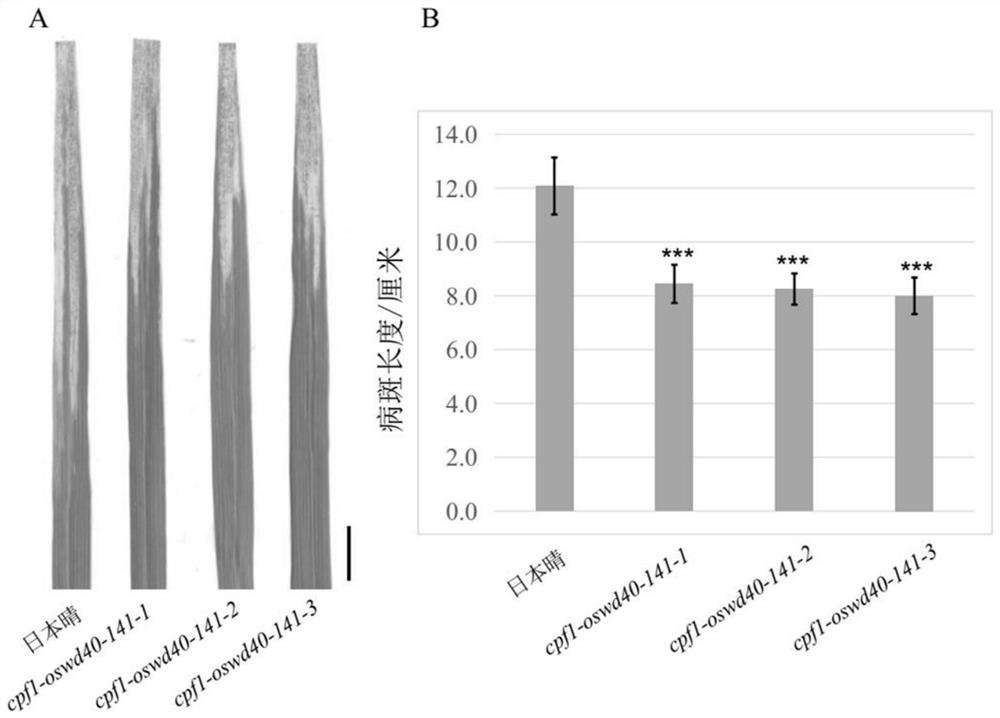Rice Wd40-enriched repeat protein oswd40-141 and its encoding gene and application
A technology for rice bacterial blight and rice, which is applied in the fields of application, genetic engineering, plant genetic improvement, etc., and can solve the problems of easy loss of variety resistance, easy mutation, and difficulty in utilization.
- Summary
- Abstract
- Description
- Claims
- Application Information
AI Technical Summary
Problems solved by technology
Method used
Image
Examples
Embodiment 1
[0079] Example 1. Method for targeted knockout of rice WD40-rich repeat protein gene OsWD40-141 based on Lb-CRISPR / Cpf1 system
[0080] 1. Sequence and analysis of rice WD40-rich repeat protein gene OsWD40-141
[0081] The sequence of the rice WD40-rich repeat protein gene OsWD40-141 is shown in SEQ ID No.2. Sequence analysis shows that the gene includes 14 exons, which are respectively the 144th-204th positions of the SEQ ID No.2 sequence ( First exon), 2093-2238 (second exon), 2313-2659 (third exon), 4910-5022 (fourth exon), 5092-5138 bit (fifth exon), 6715-6865 (sixth exon), 7015-7078 (seventh exon), 7255-7413 (eighth exon), 7527 -7648 (ninth exon), 8570-8644 (tenth exon), 14371-14424 (eleventh exon), 14505-14578 (twelfth exon) ), 15650-15724 (13th exon), 15885-16104 (14th exon).
[0082] In the present invention, the sequence on the promoter of the rice WD40-rich repeat protein gene OsWD40-141 is used as the OsWD40-141-T1 target sequence of the rice WD40-rich repeat pro...
Embodiment 2
[0094] Example 2. Application of targeted knockout method in rice varieties based on Lb-CRISPR / Cpf1 technology
[0095] The recombinant Agrobacterium EH105-Lb-OsWD40-141-1 was used to infect the callus induced by mature embryos of rice variety Nipponbare, and the obtained rice transformed plants were named NIP-Lb-OsWD40-141-1 respectively.
[0096] The specific method is as follows:
[0097] 1. Inoculate the recombinant Agrobacterium EH105-Lb-OsWD40-141-1 in YEB liquid medium (containing 50 μg / ml kanamycin and 20 μg / ml rifampicin), and culture it with shaking at 28°C and 200 rpm to OD600 0.6-0.8; centrifuge at 5000rpm, 4°C for 5min, resuspend the bacterial cell sediment concentration in AAM liquid medium (acetosyringone concentration is 200μM / L, pH 5.2) until the OD600 is 0.6-0.8, and obtain recombinant Agrobacterium resuspension liquid.
[0098] 2. Remove chaff from mature seeds of rice variety Nipponbare, soak in 75% ethanol for 1 min, then sterilize in NaClO solution (mix...
PUM
 Login to View More
Login to View More Abstract
Description
Claims
Application Information
 Login to View More
Login to View More - R&D
- Intellectual Property
- Life Sciences
- Materials
- Tech Scout
- Unparalleled Data Quality
- Higher Quality Content
- 60% Fewer Hallucinations
Browse by: Latest US Patents, China's latest patents, Technical Efficacy Thesaurus, Application Domain, Technology Topic, Popular Technical Reports.
© 2025 PatSnap. All rights reserved.Legal|Privacy policy|Modern Slavery Act Transparency Statement|Sitemap|About US| Contact US: help@patsnap.com



